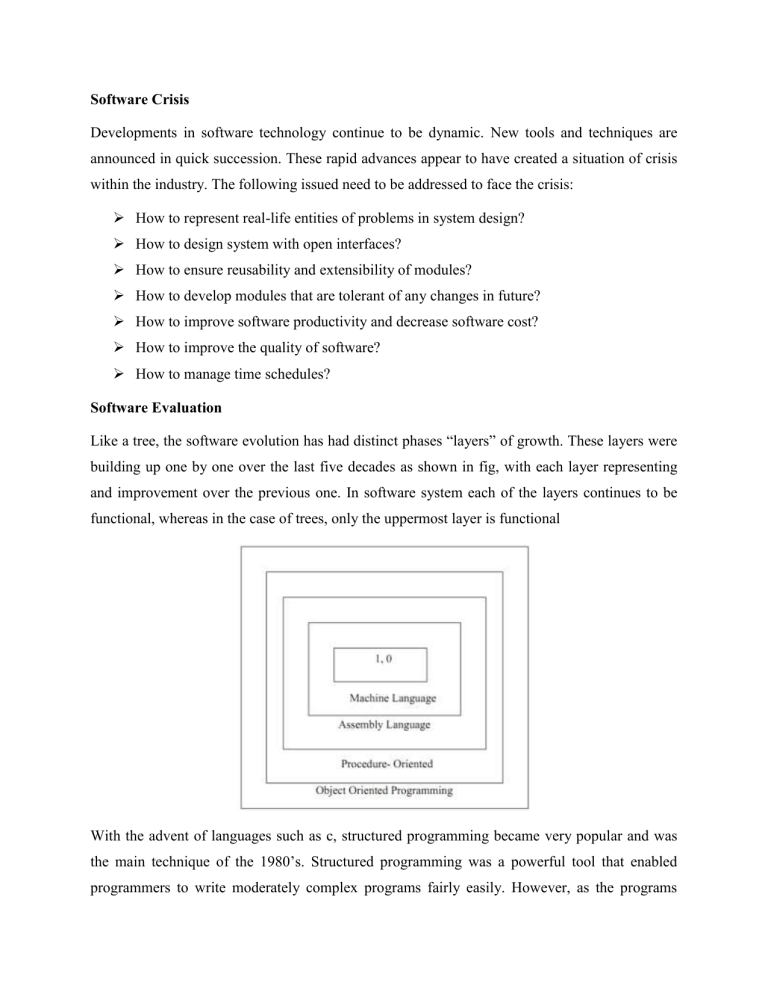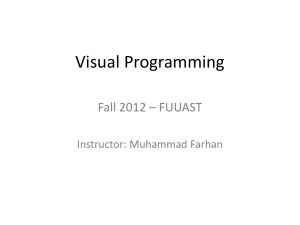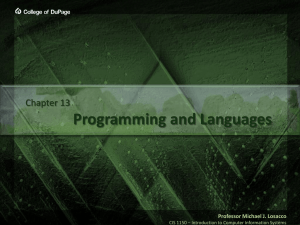
Software Crisis Developments in software technology continue to be dynamic. New tools and techniques are announced in quick succession. These rapid advances appear to have created a situation of crisis within the industry. The following issued need to be addressed to face the crisis: How to represent real-life entities of problems in system design? How to design system with open interfaces? How to ensure reusability and extensibility of modules? How to develop modules that are tolerant of any changes in future? How to improve software productivity and decrease software cost? How to improve the quality of software? How to manage time schedules? Software Evaluation Like a tree, the software evolution has had distinct phases “layers” of growth. These layers were building up one by one over the last five decades as shown in fig, with each layer representing and improvement over the previous one. In software system each of the layers continues to be functional, whereas in the case of trees, only the uppermost layer is functional With the advent of languages such as c, structured programming became very popular and was the main technique of the 1980’s. Structured programming was a powerful tool that enabled programmers to write moderately complex programs fairly easily. However, as the programs grew larger, even the structured approach failed to show the desired result in terms of bug-free, easy-to- maintain, and reusable programs. Object Oriented Programming (OOP) is an approach to program organization and development. It is a new way of organizing and developing programs and has nothing to do with any particular language. However, not all languages are suitable to implement the OOP concepts easily. Object Oriented Paradigm The major motivating factor in the invention of object-oriented approach is to remove some of the flaws encountered in the procedural approach. OOP treats data as a critical element in the program development and does not allow it to flow freely around the system. It protects it from accidental modification from outside function. OOP allows decomposition of a problem into a number of entities called objects and then builds data and function around these objects. The organization of data and function in object-oriented programs is shown in fig.1.3. The data of an object can be accessed only by the function associated with that object. However, function of one object can access the function of other objects. Some of the features of object oriented programming are: Emphasis is on data rather than procedure. Programs are divided into what are known as objects. Data structures are designed such that they characterize the objects. Functions that operate on the data of an object are ties together in the data structure. Data is hidden and cannot be accessed by external function. Objects may communicate with each other through function. New data and functions can be easily added whenever necessary. Follows bottom up approach in program design. Basic Concepts of Object oriented Programming It is necessary to understand some of the concepts used extensively in object-oriented programming. These include: Objects Classes Data abstraction and encapsulation Inheritance Polymorphism Dynamic binding Message passing Objects Objects are the basic run time entities in an object-oriented system. They may represent a person, a place, a bank account, a table of data or any item that the program has to handle. An object is said to be an instance of a class. Defining an object is similar to defining a variable of any data type. Space is set aside for it in memory. Class Classes are user-defined that types and behave like the built-in types of a programming language. A class is a logical abstraction. It is a template that defines the form of an object. A class specifies both code and data. It is not until an object of that class has been created that a physical representation of that class exists in memory. Data abstraction and encapsulation The wrapping up of data and function into a single unit (called class) is known as encapsulation. Data and encapsulation is the most striking feature of a class. The data is not accessible to the outside world, and only those functions which are wrapped in the class can access it. These functions provide the interface between the object’s data and the program. This insulation of the data from direct access by the program is called data hiding or information hiding. Inheritance Inheritance is the mechanism by which one class can inherit the properties of another. In OOP, the concept of inheritance provides the idea of reusability. This means that we can add additional features to an existing class without modifying it. This is possible by deriving a new class from the existing one. The new class will have the combined feature of both the classes. Polymorphism Polymorphism is another important OOP concept. Polymorphism means the ability to take more than on form. An operation may exhibit different behavior is different instances. The behavior depends upon the types of data used in the operation. The process of making an operator to exhibit different behaviors in different instances is known as operator overloading. Using a single function name to perform different type of task is known as function overloading. Dynamic Binding Binding refers to the linking of a procedure call to the code to be executed in response to the call. Dynamic binding means that the code associated with a given procedure call is not known until the time of the call at run time. Message Passing An object-oriented program consists of a set of objects that communicate with each other. The process of programming in an object-oriented language, involves the following basic steps: 1. Creating classes that define object and their behavior, 2. Creating objects from class definitions, and 3. Establishing communication among objects. Objects communicate with one another by sending and receiving information much the same way as people pass messages to one another. The concept of message passing makes it easier to talk about building systems that directly model or simulate their real-world counterparts. Benefits of OOP Through inheritance, we can eliminate redundant code extend the use of existing Classes. We can build programs from the standard working modules that communicate with one another, rather than having to start writing the code from scratch. This leads to saving of development time and higher productivity. The principle of data hiding helps the programmer to build secure program that cannot be invaded by code in other parts of a programs. It is possible to have multiple instances of an object to co-exist without any interference. It is possible to map object in the problem domain to those in the program. It is easy to partition the work in a project based on objects. The data-centered design approach enables us to capture more detail of a model can implemental form. Object-oriented system can be easily upgraded from small to large system. Message passing techniques for communication between objects makes to interface descriptions with external systems much simpler. Software complexity can be easily managed. Object Oriented Language Object-oriented programming is not the right of any particular languages. Like structured programming, OOP concepts can be implemented using languages such as C and Pascal. However, programming becomes clumsy and may generate confusion when the programs grow large. A language that is specially id designed to support the OOP concepts makes it easier to implement them. The languages should support several of the OOP concepts to claim that they are object-oriented. Depending upon the features they support, they can be classified into the following two categories: 1. Object-based programming languages, and 2. Object-oriented programming languages. Object-based programming is the style of programming that primarily supports encapsulation and object identity. Major feature that are required for object based programming are: Data encapsulation Data hiding and access mechanisms Automatic initialization and clear-up of objects Operator overloading Languages that support programming with objects are said to the objects-based programming languages. They do not support inheritance and dynamic binding. Ada is a typical object-based programming language. Object-oriented programming language incorporates all of object-based programming features along with two additional features, namely, inheritance and dynamic binding. Objectoriented programming can therefore be characterized by the following statements: Object-based features + inheritance + dynamic binding Application of OOP Real-time system Simulation and modeling Object-oriented data bases Hypertext, Hypermedia, and expertext AI and expert systems Neural networks and parallel programming Decision support and office automation systems CIM/CAM/CAD systems Application of C++ C++ is a versatile language for handling very large programs; it is suitable for virtually any programming task including development of editors, compilers, databases, communication systems and any complex real life applications systems. Since C++ allow us to create hierarchy related objects, we can build special objectoriented libraries which can be used later by many programmers. While C++ is able to map the real-world problem properly, the C part of C++ gives the language the ability to get closed to the machine-level details. C++ programs are easily maintainable and expandable. When a new feature needs to be implemented, it is very easy to add to the existing structure of an object. It is expected that C++ will replace C as a general-purpose language in the near future.



